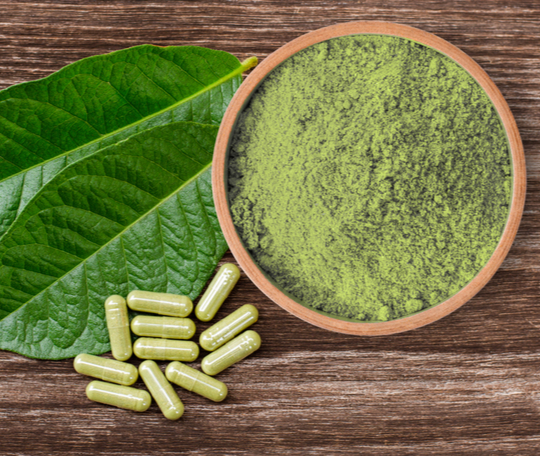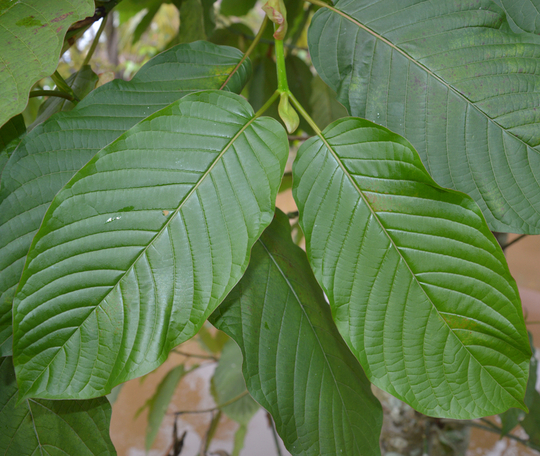PHARMACOLOGY PROFILES
Kratom
9-methoxy-corynantheidine (Mitragynine) and 7-hydroxymitragynine
C23H30N2O4(Mitragynine) &
C23H30N2O5 (7-hydroxymitragynine)
Drug Classification
Indole Alkaloid
Common Names
Krypton, Ketum, Biak, Thom, Kakuam, Ithang
Binomial Nomenclature
Mitragyna speciosa

Mitragyna speciosa

Mitragyna speciosa

Mitragyna speciosa
Overview
Mitragyna speciosa, commonly known as kratom, is an evergreen tree native to the jungles of Southeast
Asia. It grows wild in certain areas in the Pacific Rim, such as central and southern Thailand,
Malaysia, Indonesia, and Myanmar, where it has been used as traditional medicine since at least the
19th century. The main psychoactive compounds found in the tree’s leaves are 7-hydroxymitragynine
and mitragynine– a compound often compared to psilocybin because of its 4-substitute structure.
Experts are unsure of when people first started to use kratom but it has thought to be an ancient
practice. It was first tested on humans in 1932 and was likened to cocaine for its stimulant effects
on the central nervous system. When taken in small doses, it can be used to substitute caffeine,
propagating the effects of coffee without a caffeine crash. In large doses, it can mimic the effects
of opiates and can deliver a sedative effect. For the most part, users generally report feeling
energetic, sociable, motivated, and euphoric. Though there are no mainstream medical uses for
kratom, it has been known to relieve pain, soothe fevers, manage diabetes, and, most notably, treat
addiction and physical withdrawals. Some experts even believe it can replace methadone for heroin
addiction. Despite growing interest in kratom’s medical potential, places like Thailand and
Australia banned it by the early 2000s. In the United States, kratom remains legal thanks to
advocacy and campaign groups.
It is highly recommended to use harm reduction practices if using this substance in large
doses.
Dose and Duration
Kratom has been used as an alternative medicine since the early 2000s. It has been known to induce
deep relaxation or sedation, suppress anxiety, and produce euphoric feelings. In small doses, kratom
can act as a caffeine-like stimulant, enhancing focus and motivation, while larger doses can have
sedative effects. There are reports that kratom can also help with opioid addiction and the initial
physical withdrawal phase of substance detoxification. When taken for these purposes, some users
will have a morning and night routine that varies in dosage. Both small and low doses can be used
for recovery and drug addiction.
The general recommended dose for kratom is as follows:
- Light: 1 – 2 g of dried leaf or powder
- Medium: 3 – 5 g of dried leaf or powder
- Strong: 5+ g of dried leaf or powder
The total effects of kratom should last between 2 to 4 hours, with the peak lasting about 1 to 2
hours but feeling much more significantly plateaued than a caffeine spike.
Effects
The main psychoactive compounds found in kratom are 7-hydroxymitragynine and mitragynine— a compound
often compared to psilocybin because of its 4-substitute structure. 7-hydroxymitragynine mainly acts
as a mu-opioid receptor agonist, but it can act on kappa-opioid receptors as well, whereas
mitragynine is a parietal mu-, delta-, and kappa-opioid receptor agonist. Mitragynine can also act
on the 5-HT2A serotonin receptors and alpha2-adrenergic receptors.
Experts are still unsure how kratom stimulates effects, but it is likely that there is another
alkaloid involved.
Experience
Kratom was first tested on humans in 1932 and was likened to cocaine for its stimulant effects on the
central nervous system. Most users report feeling energetic, sociable, motivated, and euphoric.
Though there are no mainstream medical uses for kratom, it has been known to relieve pain, soothe
fevers, manage diabetes, and treat addiction.
Other shared experiences include:
- Dizziness
- Visual Disconnection
- Enhanced Focus
- Accelerated Thoughts
- Double Vision
- Enhanced Motivation
- Suppressed Appetite
Benefits
Research into the therapeutic benefits of kratom is limited, but experts believe kratom can
potentially act as an analgesic. It is commonly used as an aid to the withdrawal symptoms of opioids
and heroin and can also help treat depression and anxiety. When used recreationally in low doses as
a caffeine substitute, it can boost energy and productivity for the entire day, mitigating the
effects of a caffeine crash. In more traditional settings, kratom has been used to soothe fevers and
treat diarrhea and diabetes.
Kratom is also known to elicit deep emotional healing and personal growth. It helps users get out of
negative thought loops and draws attention to issues that can be resolved instead.
Risks
Though generally considered safe, there is still much research that needs to be done before anything
is known for certain. There have been some reports of seizures, however, they are mostly attributed
to certain drug combinations in tandem with kratom use and predispositions manifesting. Side effects
from long-term use has been reported to affect the liver, with some users reporting nausea, dark
urine, and abdominal pain.
Kratom is illegal in most parts of the world. In 2016, the DEA tried to place kratom on the US’s list
of Schedule I substances. Following the lobbying efforts from patients and the American Kratom
Association, the DEA withdrew their notice later the same year. Currently, kratom is heavily
regulated in certain states, counties, and towns, and can be found online from legal vendors.